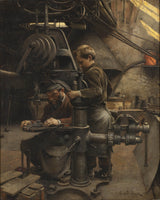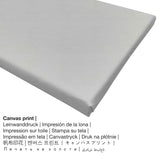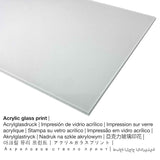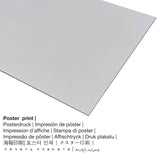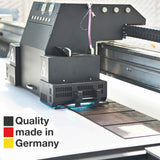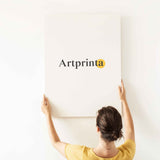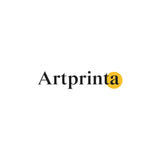Jean-Eugène Buland, 1888 - Un Patron ma ọ bụ nkuzi nke onye nkuzi - ọmarịcha nka.
Ụtụ gụnyere. Mbupu gbakọrọ na ndenye ọpụpụ.
Nkọwapụta nka site na ihe ngosi nka (© Nwebiisinka - nke Nationalmuseum Stockholm - National Museum nke Stockholm)
English: The French defeat in the war with Germany in 1871 was blamed partly on the slow industrialization of France. Therefore, huge efforts were made to modernize the country – a process that was also reflected in painting. Even though depictions of rural labor remained more frequent, pictures of the metal industry also existed – scenes from iron and steel mills, weapons factories and railroad track factories. To realistically represent this combined smithy and mechanical workshop, the artist used photographs. The foreman is using a drill to make a cogwheel – a vital component that keeps the entire modern machinery rolling. Förlusten i kriget mot Preussen 1871 ansågs delvis bero på Frankrikes långsamma industrialisering. Nu satsades det därför stort på modernisering – en utveckling som även avspeglades i konsten. Flera konstnärer hämtade motiv från metallindustrin – järn- och stålverk, vapensmedjor eller tillverkning av järnvägsräls. För att realistiskt skildra den här kombinerade smedjan och mekaniska verkstaden arbetade Buland efter fotografier. Med borrmaskin bearbetar verkmästaren ett kugghjul – en viktig komponent som får hela det moderna maskineriet att snurra.
Nkọwapụta nka
| Aha eserese ahụ: | "Un Patron or The lesson of the Apprentice" |
| Nhazi: | sere |
| Okwu mkpokọta: | nkà nke oge a |
| Time: | 19th narị afọ |
| Year: | 1888 |
| Afọ nka: | ihe dị ka afọ 130 |
| Ihe osise izizi: | mmanụ na kwaaji |
| Akụkụ nke ihe osise izizi: | Ogologo: 102 cm (40,1 ″); Ogologo: 82 cm (32,2 ″) |
| Ụlọ ihe ngosi nka / ebe: | National Museum nke Stockholm |
| Ebe ngosi nka: | Stockholm, Obodo Stockholm, Sweden |
| ibe weebụ: | www.nationalmuseum.se |
| Ụdị nka nka: | ngalaba ọha |
| Site n'aka: | Nationalmuseum Stockholm na Wikimedia Commons |
Tebụl ozi omenkà
| Aha onye nka: | Jean-Eugéne Buland |
| okike nke onye nka: | nwoke |
| Obodo onye nka: | French |
| Ọrụ: | onye na-ese ihe |
| Obodo onye nka: | France |
| nhazi ọkwa: | omenkà nke oge a |
| Ụdị nka: | Ihe ngosi |
| Akwụsị: | 74 afọ |
| Afọ ọmụmụ: | 1852 |
| Obodo: | Paris |
| Afọ ọnwụ: | 1926 |
| Ebe ọnwụ: | Charly-sur-Marne, Département Aisne |
Ihe omuma
| Ụdị ngwaahịa: | ọmarịcha nka |
| Mmeputakwa: | dijitalụ mmeputakwa |
| Usoro mmepụta: | Mbipụta UV / dijitalụ |
| Nlụpụta: | emepụtara na Germany |
| Stockdị ngwaahịa: | na mmepụta ihe |
| Ihe eji eme atụmatụ: | mgbidi mgbidi, mgbidi ịchọ mma |
| Nhazi nka nka: | nhazi ihe osise |
| Ụdị anya: | 1: 1.2 |
| Pụtara nha akụkụ: | ogologo bụ 20% mkpụmkpụ karịa obosara |
| Akwa ngwaahịa dị: | akwụkwọ mmado (akwụkwọ kwaaji), mbipụta enyo acrylic (nwere ezigbo mkpuchi iko), mbipụta akwa akwa, mbipụta ọla (aluminium dibbond) |
| Nhọrọ nke Canvas Mbipụta (akwa akwa na etiti ihe ndọtị): | 50x60cm - 20x24", 100x120cm - 39x47", 150x180cm - 59x71" |
| Acrylic glass print (nwere ezigbo mkpuchi iko) nhọrọ: | 50x60cm - 20x24", 100x120cm - 39x47" |
| Mpempe akwụkwọ mmado (akwụkwọ kwaaji) nha: | 50x60cm - 20x24", 100x120cm - 39x47" |
| Nhọrọ nha nha nke aluminom dibond (ihe aluminom): | 50x60cm - 20x24", 100x120cm - 39x47" |
| Nhazi nke nka nka: | biko rịba ama na emebeghi mmeputakwa a |
Họrọ ụdị ihe dị iche iche ịchọrọ
Maka akwụkwọ nka ọ bụla dị mma anyị na-enye ihe dị iche iche na nha. Nha na ihe ndị a bụ nhọrọ anyị na-enye gị maka nkeonwe:
- Ugogbe acrylic ebipụtara: The print on acrylic glass, often referred to as a an art print on plexiglass, changes your favorite original into brilliant décor. The artwork will be made with state-of-the-art UV direct print machines. This makes sharp and rich print colors. The plexiglass protects your chosen art replica against sunlight and heat for up to 60 years.
- Mbipụta kanvas: A canvas direct print is a printed cotton canvas stretched on a wooden frame. A canvas creates a cosy, positive feeling. Hanging your canvas print: Canvas Prints have the advantage of being relatively low in weight, which implies that it is quite simple to hang your Canvas print without the help of additional wall-mounts. That is why, canvas prints are suited for all types of walls.
- Mpempe akwụkwọ ederede (akwa akwa akwa): A poster is a UV printed cotton canvas paper with a slight surface structure. Please note, that depending on the size of the canvas poster print we add a white margin 2 - 6cm round about the painting in order to facilitate the framing.
- Aluminom dibond mbipụta (ọla): Aluminium Dibond prints are prints on metal with a true effect of depth. The non-reflective surface make a fashionable impression. A direct Direct Print on Aluminum Dibond is the excellent start to art replicas with aluminum. The bright parts of the original artpiece shimmer with a silky gloss, however without glow. The colors are luminous and bright in the highest definition, details of the print are clear and crisp. This print on Aluminum Dibond is one of the most demanded entry-level products and is a truly modern way to display artworks, as it draws focus on the whole artwork.
Ihe osise ọgbara ọhụrụ a aha ya bụ Un Patron or The lesson of the Apprentice ka nwoke na-ese ihe sere ya Jean-Eugéne Buland. The painting was painted with the size: Height: 102 cm (40,1 ″); Width: 82 cm (32,2 ″) and was crafted with the medium mmanụ na kwaaji. What is more, this piece of art forms part of the art collection of Nationalmuseum Stockholm in Stockholm, Obodo Stockholm, Sweden. a nkà nke oge a artpiece, nke bụ akụkụ nke ngalaba ọha a na-agụnye na nkwanye ùgwù nke Nationalmuseum Stockholm na Wikimedia Commons.: . Besides this, the alignment of the digital reproduction is in portrait format with an aspect ratio of 1: 1.2, which means that the length is 20% shorter than the width. Jean-Eugène Buland was a painter, whose art style can be classified as Realism. The Realist painter lived for 74 afọ - born in the year 1852 in Paris and deceased in the year 1926 in Charly-sur-Marne, Département Aisne.
Ozi dị mkpa: We try in order to describe the art products with as many details as possible and to demonstrate them visually on the product detail pages. Nonetheless, the pigments of the print products, as well as the printing may diverge somehwat from the image on your device's screen. Depending on the settings of your screen and the quality of the surface, not all color pigments are printed 100% realistically. Considering that our art reproductions are printed and processed manually, there might also be slight variations in the motif's size and exact position.
© nwebisiinka, Artprinta (www.artprinta.com)

